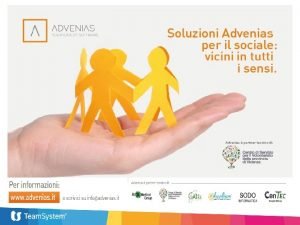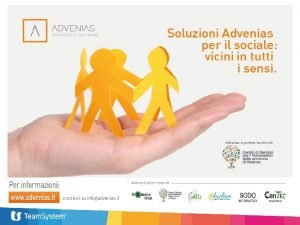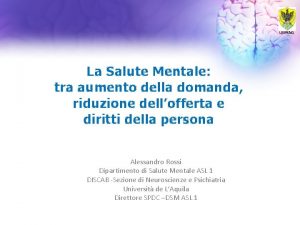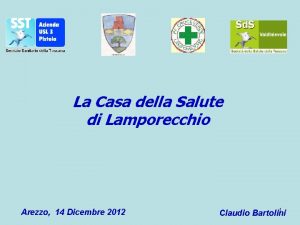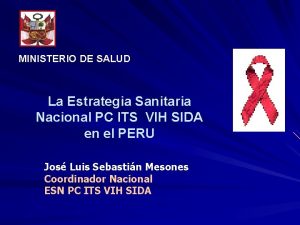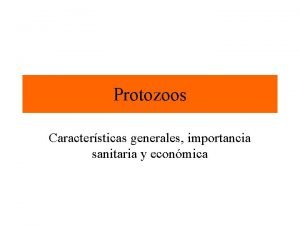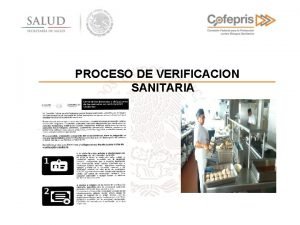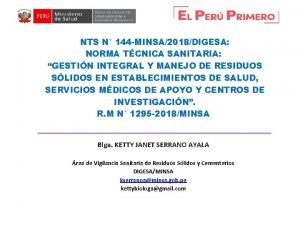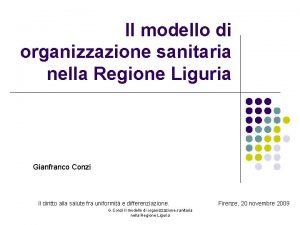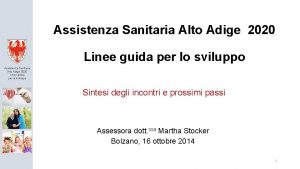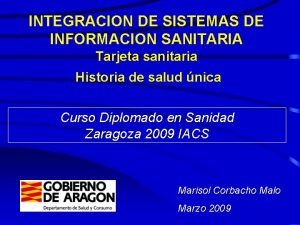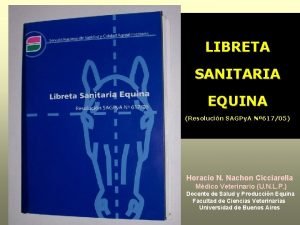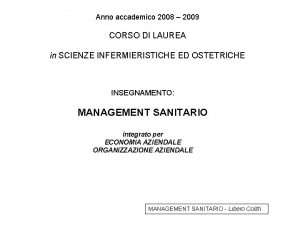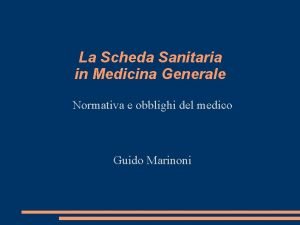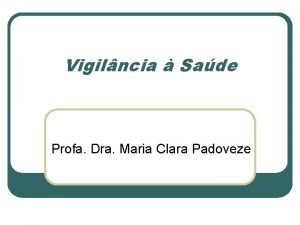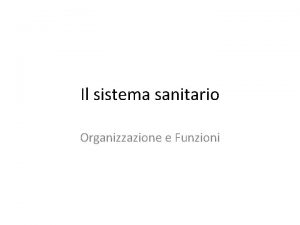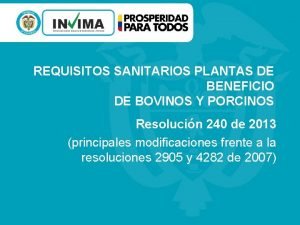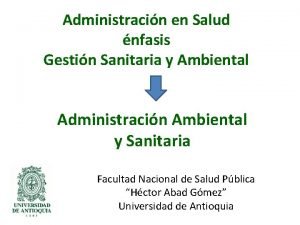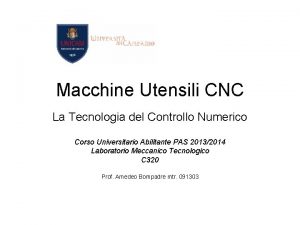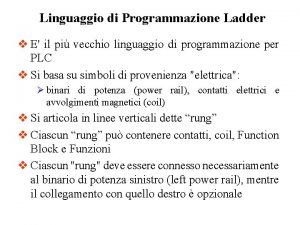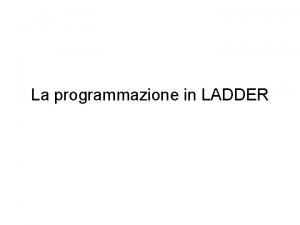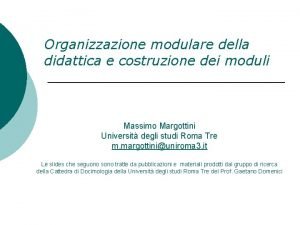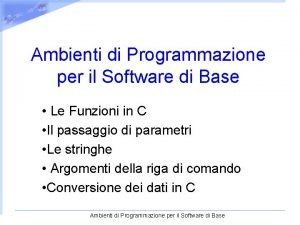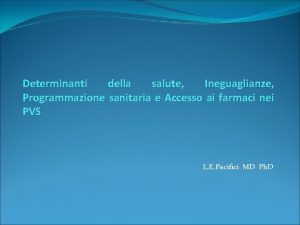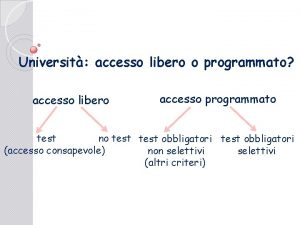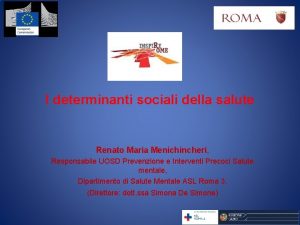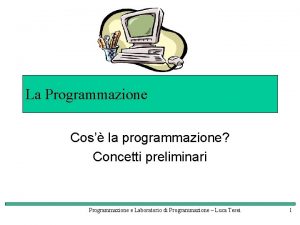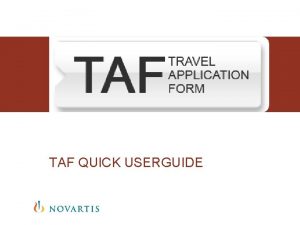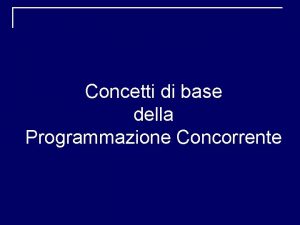Determinanti della salute Ineguaglianze Programmazione sanitaria e Accesso


















































- Slides: 50

Determinanti della salute, Ineguaglianze, Programmazione sanitaria e Accesso ai farmaci nei PVS L. E. Pacifici MD Ph. D

Determinanti della salute, Ineguaglianze, Programmazione sanitaria e Accesso ai farmaci nei PVS (in un acronimo) sono detti tutti quei paesi compresi nella parte I della lista stilata dall'OCSE, l'Organizzazione per la Cooperazione e lo Sviluppo Economico. Si tratta di paesi con livelli di sviluppo molto bassi, suddivisi in 5 categorie, in base al livello medio di reddito pro capite


Determinanti della salute, Ineguaglianze, Programmazione sanitaria e Accesso ai farmaci nei PVS DUE DIVERSI APPROCCI ALLA SALUTE Filosofie economiche differenti Comprehensive (Conferenza Alma Ata 1978) Selective (Banca Mondiale, grandi fondazioni)

Dagli MDG ai Sustainable Development Goals (SDGs) • At the United Nations Sustainable Development Summit on 25 September 2015, world leaders adopted the 2030 Agenda for Sustainable Development, which includes a set of 17 Sustainable Development Goals (SDGs) to end poverty, fight inequality and injustice, and tackle climate change by 2030. “World leaders have an unprecedented opportunity this year to shift the world onto a path of inclusive, sustainable and resilient development" - Helen Clark, UNDP Administrator.

Sustainable Development Goals (SDGs)

Sustainable Development Goals (SDGs) The Sustainable Development Goals, otherwise known as the Global Goals, build on the Millennium Development Goals (MDGs), eight anti-poverty targets that the world committed to achieving by 2015. The MDGs, adopted in 2000, aimed at an array of issues that included slashing poverty, hunger, disease, gender inequality, and access to water and sanitation. Despite this success, the indignity of poverty has not been ended for all. the new sdgs, and the broader sustainability agenda, go much further than the mdgs, addressing the root causes of poverty and the universal need for development that works for all people.


Health determinants and Health inequalities Health is not just the outcome of genetic or biological processes but is also influenced by the social and economic conditions in which we live. These influences have become known as the ‘social determinants of health’. Inequalities in social conditions give rise to unequal and unjust health outcomes for different social groups Dr. KANUPRIYA CHATURVEDI Dr. S. K CHATURVEDI

Social determinants of health These refer to the social, economic, and political situations that affect the health of individuals, communities, and populations. Absolute and relative inequalities in health Inequality in health is an empirical notion and refers to differences in health status between different groups. It is a multidimensional concept, consisting of technical and normative judgments in the choice of appropriate metrics. We have presented absolute and relative inequalities. Inequity in health and health care Inequity in health is a normative concept and refers to those inequalities that are judged to be unjust or unfair because they result from socially derived processes. Equity in health care requires active engagement in planning, implementation, and regulation of health systems to make unbiased and accountable arrangements that address the needs of all members of society.

Social Determinants The social conditions in which people live powerfully influence their chances to be healthy. Indeed factors such as poverty, food insecurity, social exclusion and discrimination, poor housing, unhealthy early childhood conditions and low occupational status are important determinants of most diseases, deaths and health inequalities between and within countries’ (WHO 2004)

Social Determinants Health is influenced, either positively or negatively, by a variety of factors. Some of these factors are genetic or biological and are relatively fixed. ‘Social determinants of health’ arise from the social and economic conditions in which we live and are not so fixed. 1. housing and environments 2. education services 3. incomes 4. type of work can all influence our health, and the lifestyle decisions we make.


Key Social Determinants of Health 1. Poverty and Inequality. 2. Social Exclusion and Discrimination. 3. A Life Course Perspective 4. Public Policies and Services 5. The Built Environment 6. Work and Employment 7. Community and Social Participation 8. Health Behaviours 9. Stress

Measuring Health Inequalities Adequate baseline data is necessary to help us understand health inequalities more fully and to help identify appropriate targets and interventions to reduce them. For exemple nformation about : death, illness, health and health service use. Information about how these health indicators are patterned across different demographic or socio-economic groups and across different geographical areas

Health Equity Health equity is defined as the ‘absence of unfair and avoidable or remediable differences in health’ among social groups (Solar and Irwin 2007). Health equity is therefore about the values of fairness and justice. A focus on health equity means valuing health as an essential and valuable resource for human development, helping people reach their potential and contribute positively to society. Health also represents an important public good, an investment in human, societal and economic development.

How to do ? Focusing on the most disadvantaged groups: This targets the worst off or poorest groups and aims to improve their health through specific measures. This approach can improve the health of those who are worst off, even if the health gap between rich and poor is unchanged. Narrowing health gaps : This aims to improve the health of those who are poorest or most disadvantaged by raising their health outcomes closer to those who are most advantaged. This usually involves target setting to reduce the disparity in health outcomes between the most advantaged and most disadvantaged groups. Reducing the social gradient : Tackling the social gradient in health involves reducing differences and equalising health all along the income ladder

Guiding Principles Actions should be concerned with tackling the social determinants of health inequalities. Stated policy intentions are not enough: the possibility of actions doing harm must be monitored and assessed through health equity impact assessment. Concerted efforts must be made to give a voice to the voiceless.

Policy issues Strategies to reduce poverty and inequality are fundamental to reducing health inequalities. Long-term targets for greater health equity and the reduction of health inequalities need to become government priorities, and need to be championed, resourced, reviewed and supported by medium and shorter term goals, actions. Policies and actions to address poverty, social exclusion and health inequalities need to be mainstreamed into all policy areas. Working for health equity requires a joined-up approach across government departments and cross sectoral partnerships between and within sectors.

Social exclusion is often compounded by discrimination, which can arise on the basis of a person’s gender, race or ethnicity, disability, marital, family or caring status, age, religion Equality legislation has an important role to play in tackling these forms of discrimination and promoting greater equality, inclusion, and diversity.

Gender differences in health and mortality are complex and not yet fully understood. The social determinants of health have both similar and different effects on men and women. Women seem to have a biological advantage over men in terms of life expectancy. Men tend to die younger than women, and research suggests that the work they do and issues like job security and unemployment often affect men’s health.

Conceptual framework for understanding health inequalities (Dr. KANUPRIYA CHATURVEDI , Dr. S. K CHATURVEDI)

Gestione di farmaci e vaccini nei PVS: secondo voi Sono accessibili a tutte le popolazioni che ne hanno effettivo bisogno? Vengono rispettati gli standard di qualità nella produzione? Esiste una attività di sensibilizzazione sull’ importanza della ricerca nell’ambito di patologie definite NID? Vengono conservati adeguatamente?

Farmaci e vaccini nei PVS Accesso a farmaci essenziali Copertura del territorio Ricerca (es. NID) Qualità Produzione Conservazione Costi Distribuzione Approvvigionamento Conservazione/ utilizzo Stoccaggio Cosa implica la gestione di farmaci e vaccini nei PVS? Gestione nel magazzino e sul campo distribuzione Eliminazione

Accesso a cosa? Perché? Essential Drugs are those drugs that meet the health needs of the majority of the population, they should be available at all times in adequate amounts and in appropriate dosage forms. * Immunization has been identified as one of the most cost effective health interventions. ** Oggi tratteremo i problemi relativi all’accesso (approvvigionamento/ conservazione) dei farmaci essenziali e vaccini sul territorio. *WHO drug information Vol 14, N° 2, 2000. “General Policy Issues” **Bulletin on the World Health Organization vol. 82 no. 2 2004.

The GAVI Alliance Is a unique organisation that aligns public and private resources in a global effort to create greater access to the benefits of immunisation. It does this with precision and in creative, innovative ways to ensure that donor contributions efficiently save lives and help build self-sufficiency in the world’s poorest communities and regions.

GAVI

Ciò che arriva è sempre ciò che serve?

Negli ultimi anni grande mobilitazione internazionale In caso di conflitti armati In caso di calamità naturali

Un esempio : SUDAN 1990 Scatole di farmaci usati Scatole di farmaci in lingua francese Farmaci inadatti e pericolosi Soluzioni per lenti a contatto Stimolanti dell’appetito Soluzioni per raggi X

LINEE GUIDA OMS Conformità ai bisogni del Paese e nel rispetto delle sue politiche sanitarie No farmaci di recupero Scadenza minima ad 1 anno Istruzioni in lingua comprensibile Grandi quantità Informare prima il Paese destinatario

Quali sono i problemi principali? Fornitura Qualitativamente si fa riferimento alla lista dei farmaci essenziali del WHO (che comprende 312 farmaci) ed alle linee guida del WHO sui vaccini. La disponibilità di farmaci per programmi di controllo specifici si basa su studi epidemiologici sul territorio.

Quali sono i problemi principali? Fornitura Spesso è difficile stabilire con esattezza e per tempo. La quantità di farmaci necessari in modo da dato dipende da tre fattori: 1. Consumo. 2. Linee guida di trattamento. 3. Trend di morbidità. S. Foster, R. Laing et al. “Disease Control priorties in Developing Countries” chapter 72 Ensuring supplies of appropriate drugs and vaccines

Quali sono i problemi principali? Fornitura Ordinare quantità maggiore di un minor numero di farmaci facilita il processo ordinativo e limita il rischio di cadute di stock. Ordinare compresse e capsule piuttosto che sciroppi e formulazioni iniettabili riduce i costi. L’acquisto all’ingrosso di farmaci generici costa generalmente 10 volte meno dei prodotti di marca. S. Foster, R. Laing et al. “Disease Control priorties in Developing Countries” chapter 72 Ensuring supplies of appropriate drugs and vaccines

Quali sono i problemi principali? Fornitura Esistono organizzazioni come IDA (International Dispensary Association) e l’ UNICEF che acquistano grandi stock di farmaci che possono rivendere a prezzi competitivi generalmente ad organizzazioni no -profit.

http: //www. supply. unicef. dk/catalogue/

E’ possibile acquistare anche kit di emergenza, un pacchetto standard preconfezionato di rapido impiego in situazioni di emergenza laddove non si ha il tempo di valutare l’ordinativo.

Tornando al nostro schema: Tuttavia i costi non comprendono solo l’acquisto di farmaci e vaccini ma anche la loro gestione.

Quali sono i problemi principali? Perché dovremmo spendere per la gestione? La modalità di conservazione e trasporto di farmaci e vaccini ne influenza la qualità.

Quali sono i problemi principali? Qualità

Scopo Scoprire e produrre il farmaco/vaccino. Livello Ricerca e produzione Argomenti correlati Ricerca nuovi vaccini e farmaci. http: //www. who. int/immunization_delivery/new_vaccines/en/ Neglected drugs msf 2006 http: //www. msf. org/msfinternational/invoke. cfm? component=article&obje ctid=2753 A 561 -D 23 D-631 D-B 583 C 5 F 9 A 9 EEC 3 CB&method=full_html PRODUZIONE Conformità con i prerequisiti WHO http: //mednet 3. who. int/prequal/ Contraffazione di farmaci http: //www. who. int/medicines/counterfeit_conference/en/ Renderlo economicamente disponibile. Accesso economico WHO-WTO paper on Equitable pricing for essential drugs http: //www. wto. org/english/tratop_e/trips_e/who_background_e. pdf Intellectual property http: //www. cid. harvard. edu/cidtrade/issues/ipr. html Msf A guide to the post-2005 world: TRIPS, R&D and access to medicines http: //www. msf. org/msfinternational/invoke. cfm? component=article&obje ctid=88694 E 5 B-0 FED-434 A-A 21 EDA 1006002653&method=full_html The WTO, Intellectual Property Rights, and the Access to Medicines Controversy http: //www. fas. org/sgp/crs/misc/RL 33750. pdf Farlo arrivare dove c’è bisogno. Accesso logistico DISTRIBUZIONE Global Drug Facility (GDF) http: //www. stoptb. org/gdf/assets/documents/Factsheet. GDF 011205. pdf UNAIDS Improving access to care in developing countries http: //data. unaids. org/Publications/IRC-pub 02/jc 809 -access-tocare_en. pdf Strengthening health services delivery http: //ftp. who. int/gb/pdf_files/WHA 54/ea 5412. pdf Farlo arrivare in condizioni da poter essere utilizzato. Gestione Mantenimento delle caratteristiche del farmaco/vaccino (conservazione e distribuzione). CONSERVAZIONE

Quali sono i problemi principali? L’ ambiente esterno può modificare le proprietà di farmaci e vaccini. I Farmaci sono influenzati da fattori quali: • Tempo • Calore • Luce • Umidità • Contaminazione microbiologica.

Quali sono i problemi principali? L’ ambiente esterno può modificare le proprietà di farmaci e vaccini. I vaccini sono influenzati fortemente dalla temperatura di conservazione. “Vaccines are sensitive to heat and freezing and must be kept at the correct temperature from the time they are manufactured until they are used. The system used for keeping and distributing vaccines in good condition is called the cold chain. The cold chain consists of a series of storage and transport links, all designed to keep vaccines within an acceptable range until it reaches the user. ”* * World Health Organization Immunization in Practice 2004 module 3 chapter 1 “The cold chain” http: //www. who. int/vaccines-documents/Dox. Trng/h 4 iip. htm

The Cold Chain* * World Health Organization Immunization in Practice 2004 module 3 chapter 1 “The cold chain” http: //www. who. int/vaccines-documents/Dox. Trng/h 4 iip. htm Freeze sensitive vaccines*

Quindi? Dando per assodata la qualità nella manifattura del farmaco ( problema della contraffazione dei farmaci) o di un vaccino, Un farmaco può perdere la propria efficacia terapeutica o addirittura divenire tossico in relazione alle condizioni di conservazione. I vaccini sono prodotti delicati che possono essere distrutti se non maneggiati correttamente.

Conclusione 1: procurement Qualità farmaco/vaccino. Evitare carenze di stock attraverso uno studio approfondito delle necessità. Evitare farmaci contraffatti.

Conclusione 2: Conservazione e trasporto Introduzione di protocolli flessibili nella catena del freddo. Realtà dei mercati informali

Conclusione 2: Conservazione e trasporto In paesi tropicali oscillazioni della disponibilità di energia elettrica possono compromettere il funzionamento di apparecchi destinati alla conservazione di farmaci e vaccini e vanno previsti back-up energetici.

Conclusione 3: scoprire l’importanza di una policy a monte L’ utilizzo di farmaci substandard può causare: Una riduzione della risposta terapeutica Resistenza/fallimento terapeutico Tossicità

 Epersonam accesso
Epersonam accesso Svama compilabile
Svama compilabile Accesso giustizia
Accesso giustizia Programmazione lineare teoria
Programmazione lineare teoria Casa della salute bondeno servizi
Casa della salute bondeno servizi La postura della salute
La postura della salute Promozione salute
Promozione salute Statistiche univaq
Statistiche univaq Casa della salute lamporecchio
Casa della salute lamporecchio Katsayılar determinantı
Katsayılar determinantı Complementi determinanti e circostanti
Complementi determinanti e circostanti Köşegen matris
Köşegen matris Determinante
Determinante Estrategia sanitaria nacional de salud bucal
Estrategia sanitaria nacional de salud bucal Protozoos con importancia sanitaria
Protozoos con importancia sanitaria Sanitaria roseto degli abruzzi
Sanitaria roseto degli abruzzi Orden de verificación sanitaria
Orden de verificación sanitaria Estrategia sanitaria de salud bucal
Estrategia sanitaria de salud bucal Nts 144 minsa
Nts 144 minsa Organizzazione servizio sanitario regione liguria
Organizzazione servizio sanitario regione liguria Conservazione immagini radiologiche
Conservazione immagini radiologiche Organigramma azienda sanitaria
Organigramma azienda sanitaria Rete sanitaria integrata
Rete sanitaria integrata Certificado de inspección sanitaria
Certificado de inspección sanitaria Contactos sexo galicia
Contactos sexo galicia Tarjeta sanitaria equina
Tarjeta sanitaria equina Free elaborato
Free elaborato Organigramma azienda sanitaria
Organigramma azienda sanitaria Scheda sanitaria individuale
Scheda sanitaria individuale Vigilância sanitária
Vigilância sanitária Vigilância sanitária
Vigilância sanitária Organigramma azienda sanitaria
Organigramma azienda sanitaria Muebles sanitarios
Muebles sanitarios Estandares de ejecucion sanitaria
Estandares de ejecucion sanitaria Administración ambiental y sanitaria
Administración ambiental y sanitaria Linguaggio di alto livello
Linguaggio di alto livello Programmazione procedurale
Programmazione procedurale Ambienti di programmazione per il software di base
Ambienti di programmazione per il software di base Cos'è lo zero pezzo
Cos'è lo zero pezzo Programmazione ad eventi
Programmazione ad eventi Programmazione ladder
Programmazione ladder Programmazione cnc simulator
Programmazione cnc simulator Simbologia ladder pdf
Simbologia ladder pdf Linguaggio di programmazione cruciverba
Linguaggio di programmazione cruciverba Organizzazione modulare
Organizzazione modulare Programmazione e sviluppo condiviso peer to peer
Programmazione e sviluppo condiviso peer to peer Programmazione procedurale
Programmazione procedurale Ambienti di programmazione per il software di base
Ambienti di programmazione per il software di base Ambienti di programmazione per il software di base
Ambienti di programmazione per il software di base Programmazione dichiarativa e imperativa
Programmazione dichiarativa e imperativa Programmazione midi
Programmazione midi
